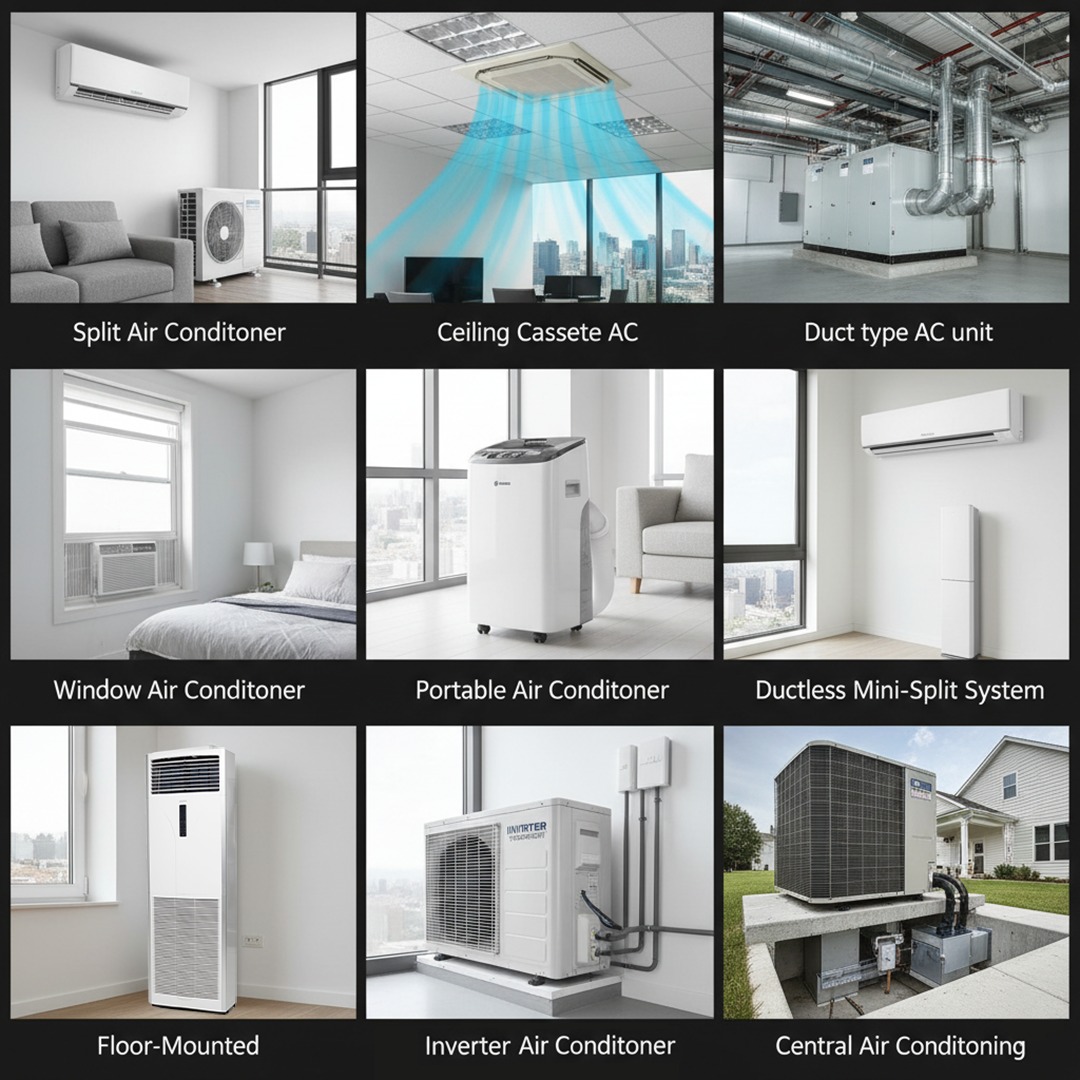

Table of Contents
ToggleChoosing the right air conditioner can feel overwhelming. With so many types, models, and features available, how do you know which one is best for your home or business? Understanding the differences between each option is the first step toward making an informed decision that ensures comfort and efficiency for years to come. This guide will walk you through the most common types of air conditioners, from the popular Split Air Conditioner to specialized commercial units.
We will explore the unique benefits and ideal applications for various systems. You’ll learn about residential options like window and portable units, as well as more complex systems like central air and geothermal solutions. By the end, you’ll have a clear picture of which air conditioning system fits your space, budget, and cooling requirements.
Before we dive into the specific types, let’s cover what all air conditioners have in common. At their core, they operate on a principle of refrigeration. They remove heat from an indoor space and transfer it outside, leaving the inside air cooler. This process involves a refrigerant, a compressor, a condenser coil, and an evaporator coil. The key differences between AC types lie in their design, capacity, and installation method.
For most homeowners, the choice comes down to a few popular types designed for residential use. These range from single-room solutions to whole-house systems.
A Split Air Conditioner is one of the most popular cooling systems worldwide, and for good reason. It consists of two main parts: an indoor unit that contains the evaporator coil and fan, and an outdoor unit that houses the compressor and condenser. These two units are connected by copper tubing and electrical wiring that run through a small hole in the wall.
This design offers several advantages. First, since the noisy compressor is located outside, the indoor operation is incredibly quiet. Second, they are more aesthetically pleasing than window units and provide better security. This system is also a type of ductless mini-split system, making it perfect for homes without existing ductwork or for cooling specific zones. For homes that need a flexible and efficient cooling solution, the Split Air Conditioner is often the top recommendation.
A Window Air Conditioner is a self-contained unit that houses all its components in a single box. As the name suggests, it is installed in a window or a dedicated wall opening. These units are an affordable and straightforward solution for cooling a single room, like a bedroom or a small studio apartment. Installation is typically a DIY project, and they are easy to operate. However, they can be noisy, block a window view, and pose a minor security risk.
Similar to a window unit, a Portable Air Conditioner is a self-contained system designed for single-room cooling. Its main advantage is mobility. You can move it from room to room as needed, providing cooling wherever you are. These units sit on the floor and use a hose to vent hot air out of a window. While convenient, they are generally less efficient than window or split systems and can take up valuable floor space.

For those looking to cool an entire house uniformly, Central Air Conditioning is the gold standard. This system uses a large outdoor compressor connected to an indoor furnace or air handler. Cool air is distributed throughout the home via a network of supply and return ducts. While it is the most expensive option upfront, it provides consistent temperature control and helps filter the air for the entire home. It’s an ideal solution for larger homes, especially those in hot climates.
Beyond typical residential units, there are several types of air conditioners designed for commercial spaces, large buildings, or unique architectural requirements.
For commercial settings like offices, retail stores, or restaurants, aesthetics and space are often primary concerns. This is where a Ceiling Cassette AC shines. This unit is installed directly into the ceiling, with only a sleek, flat grille visible. Air is drawn in through the center of the unit and distributed in up to four directions, providing even and widespread cooling without creating uncomfortable drafts.
The hidden installation of a Ceiling Cassette AC preserves wall and floor space, maintaining a clean, professional look. Its powerful performance makes it ideal for large, open-plan areas where consistent temperature is crucial. It’s a sophisticated choice that blends performance with minimalist design.
A Duct type AC unit is another system designed for seamless integration. Similar to central air, this system uses ductwork to distribute air. However, the indoor unit is completely hidden, usually installed above a suspended ceiling or in a dedicated closet. The cool air is then delivered through discreet vents or grilles placed strategically throughout the space.
This setup offers powerful, centralized cooling without any visible indoor units. A Duct type AC unit is highly effective for hotels, large offices, and venues where appearance and quiet operation are paramount. The main challenge is that installation requires sufficient ceiling space for both the unit and the ductwork. If you have the space, a Duct type AC unit provides a virtually invisible climate control solution.
When you need serious cooling power for large spaces like server rooms, event halls, or large workshops, a Cabinet AC is an excellent choice. Also known as a floor-mounted air conditioner, this is a tall, robust, self-contained unit that stands on the floor. It is designed for high-capacity cooling and can deliver a strong, directed airflow over a large area.
A Cabinet AC is built for performance and durability. Its simple installation, which doesn’t require complex wall or ceiling mounting, makes it a practical solution for industrial and commercial environments. For areas that require heavy-duty cooling without the need for intricate ductwork, the Cabinet AC offers a powerful and reliable answer.
The term RCM AC unit refers to an air conditioner that has received the Regulatory Compliance Mark (RCM). This is not a type of AC but a certification mark indicating that the product complies with the electrical safety and electromagnetic compatibility (EMC) standards in Australia and New Zealand. When you purchase an RCM AC unit, you are getting a product that has been tested and verified to meet strict safety and performance requirements.
Whether you’re buying a split system or a portable one, looking for the RCM label ensures the product is safe and reliable. Always verify that any air conditioner you consider, especially an imported one, is an RCM AC unit to guarantee it meets local standards.
To help you visualize the differences, here is a table comparing some of the most common air conditioner types.
|
AC Type |
Best For |
Installation |
Pros |
Cons |
|---|---|---|---|---|
|
Split Air Conditioner |
Single rooms, homes without ducts |
Professional |
Quiet, efficient, aesthetic |
Higher upfront cost than window units |
|
Window AC |
Single small-to-medium rooms |
DIY-friendly |
Affordable, easy to install |
Noisy, blocks window view |
|
Portable AC |
Temporary or mobile cooling needs |
DIY-friendly |
Movable, no permanent installation |
Less efficient, bulky, noisy |
|
Central Air Conditioning |
Whole-house cooling |
Professional |
Consistent temp, filtered air |
Expensive, requires ductwork |
|
Ceiling Cassette AC |
Commercial spaces, open-plan areas |
Professional |
Discreet, even air distribution |
Requires ceiling space, costly |
As technology advances, so do air conditioning systems. Modern innovations focus on energy efficiency and sustainability.
An Inverter Air Conditioner uses a variable-speed compressor that adjusts its output based on the cooling demand of the room. Unlike traditional ACs that turn on and off, an inverter system runs continuously at lower power levels once the desired temperature is reached. This results in significant energy savings, quieter operation, and more stable temperatures. Many modern split systems and other AC types now feature inverter technology.
A Geothermal Air Conditioner is a highly efficient, sustainable system that uses the stable temperature of the earth to heat and cool a home. It circulates a water-based solution through underground pipes to absorb or dissipate heat. While the initial installation cost is very high, geothermal systems offer the lowest operating costs and have a very long lifespan, making them an excellent long-term investment.
Q1: What is the most energy-efficient type of air conditioner?
Generally, geothermal systems are the most energy-efficient, followed by high-SEER inverter mini-split systems. For whole-house cooling, a high-SEER Central Air Conditioning system is a great choice. The right Split Air Conditioner with a high SEER rating can significantly lower your electricity bills compared to older models.
Q2: Can I install a split air conditioner myself?
While it may seem possible, installing a Split Air Conditioner requires handling refrigerant lines and high-voltage electrical connections. It is strongly recommended to hire a licensed HVAC professional to ensure the system is installed safely, correctly, and operates at peak efficiency.
Q3: Is a Ceiling Cassette AC suitable for a home?
Yes, a Ceiling Cassette AC can be used in residential settings, especially in large living rooms or master bedrooms with adequate ceiling space. It offers a premium, discreet look that many homeowners find appealing.
Q4: How do I choose the right size AC for my room?
The cooling capacity of an AC is measured in BTUs. As a general rule, you need about 20 BTUs per square foot of living space. However, factors like ceiling height, window size, sun exposure, and room occupancy also play a role. It’s best to consult an HVAC professional for an accurate load calculation.
Q5: What is the difference between a ductless mini-split and a split air conditioner?
The terms are often used interchangeably. A ductless mini-split system is a type of split system that doesn’t require ductwork. Most residential split systems are ductless, making them a versatile choice for many homes.
Welcome to The AC Hub, Pakistan’s trusted 3S AC dealer, committed to delivering comfort nationwide. We specialize in residential and commercial air conditioning, offering genuine products from top global brands. Our service includes expert installation, nationwide delivery, and full warranty support for your peace of mind. Experience unparalleled quality and customer satisfaction with every solution we provide.
Address: Mezzanine Floor, Office # 13, 14, Bara Tower, Near Four Season Wedding Hall, Abid Market, Qartaba Chowk, Lahore
Conatct us:
0321-7227838
0300-1234545
Email: theachub.pk@gmail.com
Monday to Saturday
9:00 AM to 9:00 PM
Address: Mezzanine Floor, Office # 13, 14, Bara Tower, Near Four Season Wedding Hall, Abid Market, Qartaba Chowk, Lahore
Reach us:
0321-7227838
0300-1234545
Email: theachub.pk@gmail.com
Monday to Saturday
9:00 AM to 9:00 PM
Powered By The Ac Hub